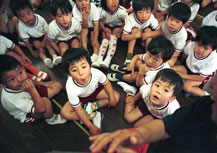Covering
Japan: Nagasaki Journal |
The Students
The Classes
Kindergarten
Cuts
Shifting Demographics Mean Fewer Youngsters in Class
By Austin Ramzy
Special to the Mercury News
(This story originally appeared in the San Jose Mercury
News on August 8, 2002. Click here
to view it on the Mercury News web site)
NAGASAKI, Japan – At the Houju Kindergarten, on the wooded grounds
of a Shinto shrine, it's time for a listening exercise.
 Sayuri Okamura reads to her class at the Houju kindergarten in Nagasaki. She has seen classes get smaller and smaller. |
The teacher tells the class to sing,
clap and dance along. To the beat of a cartoon song, 27 children in red-and-white
uniforms pound their slippers on the hardwood floor, which emits a low
rumble. A decade ago the floor would have thundered. Back then, there
were three times as many children in this school at the base of Mount
Inasa, the city's tallest peak.
In Nagasaki, the number of students is decreasing at all grade levels,
but it's felt most in the city's kindergartens, said Mariko Tanisaki,
an official with the Nagasaki City Board of Education. From 1994 to 2000,
the number of kindergarten students in the area dropped 20 percent.
The decline is just one reflection of a major demographic shift nationwide.
Fewer Japanese are having children.
Across Japan, the birth rate has declined because couples marry later
in life or worry about the high cost of raising children, and more women
are taking jobs. In May, the Home Affairs Ministry announced the number
of children younger than 15 in Japan fell for the 21st year in a row.
In the past decade, more than 600 kindergartens have closed.
Children in Japan can attend kindergarten from age 3 to 5, though it is
not required. In Nagasaki, just over half the children attend one of the
city's kindergartens, most of which are private, before compulsory education
begins at age 6.
Now, all of the students at Houju Kindergarten easily fit into one classroom
for their exercises, leaving three other classrooms vacant. The cubbyholes
where they place their shoes are mostly empty, too.
"It's sad. My feeling is I want to see as many children as possible,''
said Sayuri Okamura, a 42-year-old teacher. "My hope is to raise
children in a good environment. Children get stimulation from more children.''
One reason the number of children in kindergarten has dropped is that
more people are sending their children to day care centers, which keep
them for long hours convenient for working mothers. In the 1990s, the
number of children in day care increased 8 percent in Japan. While kindergartens
provide preschool education, day care centers look after children of parents
who work or otherwise can't take care of them during the day.
At the Ohura Day Care Center, down the block from century-old Western-style
houses in Nagasaki's former foreign concession, children take their afternoon
naps on tatami mats spread across the floor. There's hardly room to walk
between them.
"I worry about the space,'' said Yoshiko Mizura, the center's director.
"I need a lot more space because there are too many children.'' The
school has room for 60 children, but now there are 84.
Demand for day care grew during the last decade as the economy slumped,
forcing more women to take jobs, Mizura said. They choose day care over
kindergarten because day care centers are open longer.
Junko Hayashida, a 39-year-old nurse, has left her 5-year-old daughter
in day care since she was younger than a year old. "I don't know
if there are kindergartens that have these longer hours,'' she said.
The appeal of day care has kindergartens struggling to find children to
fill their empty classrooms. "It's a competition now, not just between
kindergartens but between kindergartens and day care centers,'' said Sister
Raimonda Yamada of the Catholic-run Our Lady of Nagasaki Kindergarten.
Traditionally Japanese kindergartens were open only half a day, from midmorning
to midafternoon. Now kindergartens are keeping children for more hours,
one of several new services offered as schools vie for a smaller pool
of students.
"The school didn't have a school bus before,'' said Junko Takeda,
41, as she stood in the shade of an apartment building on Nagasaki's outskirts
while waiting for her daughter. "But since the competition became
so fierce, they offered a school bus.''
As she waited, a yellow school bus from a kindergarten at a Catholic women's
college pulled up and dropped off her daughter, the name of her stop pinned
to the white blouse of her school uniform.
The Houju Kindergarten doesn't provide a bus. It's healthier for children
to walk, said director Kazuhito Shimojo. But he worries the traditional
approach turns off the parents of potential students, he said.
The competition for students also means that once highly selective kindergartens
now take any children who apply. The Catholic-run Our Lady of Nagasaki
Kindergarten once screened applicants on communication skills and physical
development, Yamada said, as children in the after-school program played
soccer in a gravel lot. While the school still conducts interviews, it
now accepts everyone, she said.
"Thirty years ago, the kindergarten chose which families to take
in,'' she said. "Now the families choose which kindergarten to go
to.''
But while families can now be pickier about kindergartens, many are concerned
about the downsides of shrinking family sizes. "It's easy to find
a school, but if we have less children we feel sorry for them,'' said
Shigetaka Yamashite, a 56-year-old father of two who was picking up his
3-year-old daughter from the Houju Kindergarten.
"I'm worried the decline in the number of children also means the
decline of the nation.''
At Our Lady of Nagasaki Kindergarten, declining attendance has made it
difficult to fund maintenance and pay teachers. The school once had as
many as 240 students. Now it just has 90, and needs 30 more to maintain
a decent income, Yamada said.
At the other end of Japan's age scale, the proportion of people older
than 65 is expected to nearly double in the next 50 years. The government
faces serious challenges in finding new ways to care for its aging population.
So while Sister Yamada says it's possible her kindergarten will close,
she and the other nuns are ready to align their work to serve Japan's
oldest citizens. "We will stay here in any case,'' she said, "because
we also run a care center for the elderly.''

